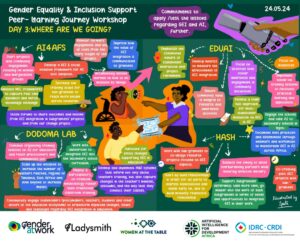This is the first blog in the “Keeping the light on: Reflections on GEI and AI in Africa” series. The writing from this series emerged from a “writeshop” organized by Gender at Work and Ladysmith as part of the “Artificial Intelligence for Development Africa,” also known as AI4D, financed by the International Development Research Centre (IDRC) and the Swedish International Development Cooperation Agency (SIDA). This was part of the final on-line Peer Learning Journeys (PLJ) workshop, modeled on Gender Action Learning (GAL), held in May, 2024.
In this first blog, Daisy Salifu, a biostatistician at the International Centre of Insect Physiology and Ecology (icipe) Data Management, Modelling and Geo-information unit, reflects on her own “aha moments” finding meaning and relevance of GEI in her own AI work in the agriculture and food systems field, implementing inclusion-by-design with women farmers and people living with disabilities in Uganda and Nigeria.
In my profession as a statistician, my day-to-day work involves working with teams of scientists, including molecular biologists, entomologists, agronomists, environmentalists, food scientists, food nutritionists, social scientists and others.
I used to perceive gender equality and inclusion (GEI) as a concern only for those at higher levels of power, such as political and corporate leaders, research scientists and others. I also assumed it applied to situations where gender balance is emphasized if not mandatory, such as in academia when considering postgraduate student enrollment. My misconception may have been due to so much campaigning about GEI integration at these levels, particularly the rule in African parliaments that no more than two thirds of its members may be of the same gender.
My misconception about the implementation of GEI felt even more dramatic in the context of research. I perceived a prominent divide between gender experts and research scientists, with gender experts on one side and research scientists on the other side, separated by a big river but without a bridge to cross over. To make matters worse, the gender experts supposedly had no clue about the length and difficulty of the journey necessary for scientists to develop the technology to address GEI concerns. Would these two groups ever share the “same space” and read from the “same script”? When will the gender experts ever stop forcing things down others’ throats? All these were my questions without answers.
The gender divide in expertise in artificial intelligence became very clear to me
In 2021, I worked on a project called, “Managing Organization (Hub) for Responsible Artificial Intelligence for Agriculture and Food Systems Innovation Research Network in Africa” (abbreviated as AI4AFS). This project required the hub to identify research sub-grantees in Africa to work on homegrown AI tools in Agriculture and Food Systems in Africa. As a hub, we were to consider GEI integration at every level of implementation of this project as per donor requirement.
Since at the time I believed that GEI applied only to higher levels of operation, I was convinced that we needed a GEI plan integrated into calls for proposals, selection of reviewers of the proposals, and selection of the sub-grantees, all the way through to the implementation of research projects by sub-grantees. Indeed, our call for Expression of Interest (EoI) targeted AI experts in sub-Saharan Africa; applicants from three main languages, English, French, and Portuguese; and woman-led AI proposals. We received 107 EoIs from 23 countries in sub-Saharan Africa, of which 22 percent were female-led. Based on this outcome, the gender divide in expertise in artificial intelligence across sub-Saharan Africa became very clear to me. Our hub’s goal was to have an equal number of female-led and male-led EoIs. Intentionally, we ended up with gender balanced Principal Investigator-led grantees (five female-led and five-male led). We emphasized and insisted that grantees’ regular progress reports to the hub include a report on GEI integration in their projects such as the number of women farmers (users) involved at the start of project, the number of women involved at design and development of innovation, and so forth. At the time, I was not sure there was much meaning in this for me other than ticking a box, to say “we have done as required”.
The turning point
However, my perspective on GEI integration in research turned around when IDRC’s GEI Support Team came on board six months after the launch of the AI4AFS project. We sat at a round table online and had a powerful, highly participatory reflective session on GEI integration from various angles, sharing personal stories of engagement in our careers, individual institution’s stories and experiences and current interests in addressing GEI through the AI4D program. For me, the discussion created a deep understanding about GEI integration in all forms of life and engagements at any level of operation.
Several workshops on GEI followed, coupled with peer learning journey workshops on GEI integration in the AI4D program. All these interaction spaces challenged my perceptions of GEI. Further, responsible AI research for development requires that nobody is left behind, nobody is discriminated against and that AI innovations benefit all.
Meanwhile, the IDRC’s GEI Support Team challenged each AI4D Africa hub with a call for expression of interest on Gender and Inclusive AI Research in the African context. This was a golden opportunity to showcase the impact of the GEI workshops. I thought and reflected on the situation of women and other marginalized small holder farmers in Africa who dominate the continent’s agriculture sector and are persistently among the lowest adopters of innovative agricultural technologies. I was concerned that our work on integration of AI in agriculture and food systems (AFS) could potentially exacerbate the existing gender disparities unless measures are taken to mitigate against such unfavorable and unethical consequences. Out of this thought, the GEI innovation challenge project: “Design by Inclusion” approach in the design, development and deployment of AI tools in AFS, was conceived.
Design-by-inclusion
Design-by-inclusion is the practice of intentionally considering and actively involving users of marginalized communities in the design process of technology. This approach ensures that user communities that often experience exclusion actively participate in the design, development, deployment and utilization of technology. We piloted a design-by-inclusion approach with two AI4AFS network women-led grantee projects: one in Nigeria and the other in Uganda.
These two projects were different: the Uganda project was a scaling up project of an AI innovation developed by another research program initiative, while the Nigeria project marked a departure from traditional approaches by actively involving women and marginalized groups from the outset in the design and development of AI tools tailored to user needs, lived experiences and perspectives.
Women farmers, together with people living with disabilities (PLWDs) already working with the research teams in the two countries, were invited to the workshop for a community dialogue. The aim was to hear and document the farmers’ opinions and experience of the challenges and constraints they face in cassava and yellow paper farming and the entire value chain, and identify top priority needs for possible AI solutions. However, we had to work retrospectively since the AI tools were already fairly well developed in both projects. To ensure a safe and comfortable environment for women, we provided the women with a women-only safe space so that they could express themselves freely. I facilitated the community dialogue in Uganda, which was a particularly memorable and rewarding experience.

This community dialogue was then followed by farmer training on use of smartphones in general and functionality of the developed AI tool. The training modules used were co-developed with the same farmers; thus women and PLWDs just to make sure that the training handled the real gaps in digital literacy as well as practical use of the AI tool.
Among the several lessons learnt, we noted the benefits of “design-by-inclusion” are that users feel valued, listened to, respected in their perspectives and opinions. Indeed, the process of collaboration empowered users to embrace, value and retain ownership of the technology.
The study also revealed that excluding user communities at the initial design stage of AI tools might result in a mismatch between the user’s top priority need and the developed AI innovation. For example, in the Uganda project, the participating farmers’ top priority was for soil nutrient analysis to inform soil suitability for cassava production, but the AI innovation was focused on early detection of cassava diseases. Such mismatch has implications on whether the user community will embrace the technology or not.
What I learned in my GEI journey
I learned that GEI was not something implemented only at the highest levels but at the grassroots as well. This experience has left an engraved mark in my career, to be shared with others now and for future as AI in AFS gets traction on the African continent.
We must be intentional in integrating GEI in research. We cannot leave things to chance. We need to keep the conversation on GEI going. While design-by-inclusion may not be the magic bullet in the development of AI innovations, it does increase the chance that a given technology will be embraced by users.
Daisy Salifu is a biostatistician at the International Centre of Insect Physiology and Ecology (ICIPE), Data Management, Modelling and Geo-information unit who has been with icipe for over 15 years, driving impactful research outcomes and fostering growth in arthropod research. Her current interest is in AI for agriculture and food systems focussing on user-led inclusive designs so that the potential of AI benefits all. You can find Daisy on LinkedIn.
This blog post is openly licensed via CC BY 4.0.



